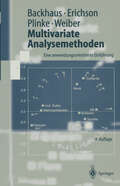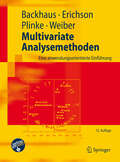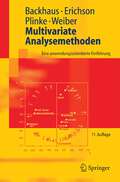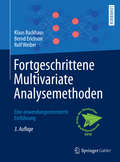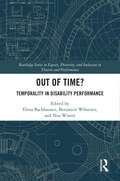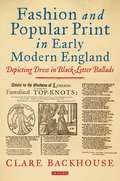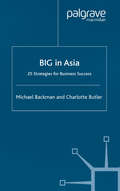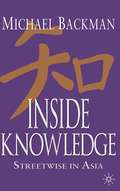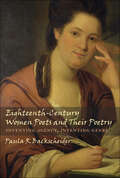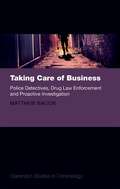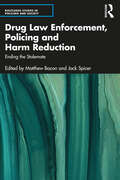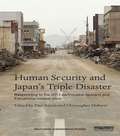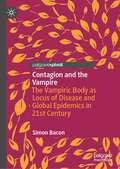- Table View
- List View
Multivariate Analysemethoden: Eine anwendungsorientierte Einführung (Springer-Lehrbuch)
by Klaus Backhaus Bernd Erichson Wulff Plinke Rolf WeiberMultivariate Analysemethoden: Eine anwendungsorientierte Einführung (Springer-Lehrbuch)
by Klaus Backhaus Bernd Erichson Wulff Plinke Rolf WeiberMit der 12. Auflage des bewährten Lehrbuchs legen wir eine neue Konzeption vor. Wir haben den methodischen Inhalt erweitert, ohne die bisherigen Verfahren einzuschränken oder zu verdrängen. Da die Erweiterung das Buch jedoch nicht mehr handhabbar macht, haben wir uns entschieden, den Leserinnen und Lesern einen zweigeteilten Weg des Zugangs zu den verschiedenen Methoden zu verschaffen. Das neue Angebot besteht neben dem Buch mit den bewährten Verfahren im Zugang zu einer Internetplattform. Das Buch umfasst die „grundlegenden Verfahren der muen Analysemethoden" in ihrer bewährten Form sowie jeweils eine kurze ltivariatEinführung in die verschiedenen „komplexen Verfahren der multivariaten Analyse". Die Plattform gewährleistet den Zugang zu den komplexen Verfahren im Detail. Wir schaffen damit eine Erweiterung des Angebots bei gleichzeitiger Möglichkeit eines selektiven Zugangs zu den tatsächlich benötigten Verfahren. Die Fallbeispiele sind mit SPSS 16.0 gerechnet.
Multivariate Analysemethoden: Eine anwendungsorientierte Einführung (Springer-Lehrbuch)
by Klaus Backhaus Bernd Erichson Wulff Plinke Rolf WeiberDas Lehrbuch behandelt 12 wichtige Verfahren der multivariaten Analysemethoden. Dies sind Regressions-, Varianz-, Diskriminanz-, Kontingenz-, Faktoren-, Cluster-, Korrespondenz- und logistische Regressionsanalyse sowie Conjoint Measurement, Multidimensionale Skalierung, Strukturgleichungsmodelle (AMOS) und Neuronale Netze (CLEMENTINE). Die Vorteile des Buches liegen in geringst möglichen Anforderungen an mathematische Vorkenntnisse, allgemeinverständliche Darstellung anhand eines für alle Methoden verwendeten einheitlichen Fallbeispiels, konsequente Anwendungsorientierung, Erläuterung der Fallbeispiele unter Verwendung von SPSS 13.0 für Windows, vollständige Nachvollziehbarkeit der zentralen Rechenoperationen durch den Leser, Aufzeigen von methodenbedingten Manipulationsspielräumen, unabhängige Erschließbarkeit jedes Verfahrens. In der 11. Auflage wurden die Neuronalen Netze im Fallbeispiel mit dem Programm CLEMENTINE neu gerechnet und die entsprechenden Outputs kommentiert. Alle Verfahren wurden überarbeitet sowie aktualisiert und alle Fallbeispiele mit SPSS 13.0 neu gerechnet. Die Ergebnisse werden anhand der aktuellen Screenshots demonstriert. Das Buch ist von besonderem Nutzen für alle, die sich mit den Methoden der multivariaten Datenanalyse vertraut machen möchten. Die Beispiele sind aus dem Marketing-Bereich entnommen, die Darstellung ist aber so einfach gehalten, dass jeder Leser die Fragestellungen versteht und auf seine spezifischen Probleme in anderen Bereichen übertragen kann. Weiterhin wird ein Informationsservice für Leser sowie ein Dozentenservice im Internet unter http://www.multivariate.de geboten.
Fortgeschrittene Multivariate Analysemethoden: Eine anwendungsorientierte Einführung
by Klaus Backhaus Bernd Erichson Rolf WeiberDieses Lehrbuch behandelt weiterführende Verfahren der multivariaten Datenanalyse und ist gezielt auf Master- und Doktoranden-Studiengänge ausgerichtet. Folgende Verfahren werden vorgestellt: - Nichtlineare Regressionsanalyse- Strukturgleichungsanalyse - Konfirmatorische Faktorenanalyse - Auswahlbasierte Conjoint-Analyse- Neuronale Netze - Multidimensionale Skalierung (MDS) - Korrespondenzanalyse. Zum Verständnis sind geringstmögliche mathematische Vorkenntnisse erforderlich und jedes Kapitel kann für sich eigenständig gelesen werden. Nach der intuitiven Erläuterung der Vorgehensweise der einzelnen Verfahren werden diese mit Hilfe eines ausführlichen Fallbeispiels sowie unter Verwendung der Statistik-Software IBM SPSS und teilweise auch mit MS Excel und der Conjoint-Software von Sawtooth sowie AMOS gerechnet und interpretiert. Dabei wurde Wert darauf gelegt, dass alle Rechenschritte für den Anwender nachvollziehbar sind, und es werden Anwendungsempfehlungen gegeben. Auf der Internetseite multivariate.de bieten wir weitere Serviceleistungen. Von Dozenten können u. a. die Abbildungen angefordert werden.Die hier dargestellten Verfahren waren bis 2011 Bestandteil des Lehrbuchs Multivariate Analysemethoden. Dort werden die vor allem für das Bachelor-Studium zentralen Verfahren der Regressions-, Zeitreihen-, Varianz-, Diskriminanz-, logistischen Regressions-, Kontingenz-, Faktoren-, Cluster- und Conjoint-Analyse behandelt. Das bereits in der 14. Auflage vorliegende Buch Multivariate Analysemethoden der Autoren wurde im Jahr 2015 anlässlich des 50. Kongresses der Deutschen Marktforschung des BVM Berufsverband Deutscher Markt- und Sozialforscher e. V. mit dem Preis der Deutschen Marktforschung ausgezeichnet, weil es die deutsche Marktforschungspraxis in den letzten Jahrzehnten nachhaltig geprägt hat.In der 3. Auflage des Werks Fortgeschrittene Multivariate Analysemethoden wurden alle Kapitel überarbeitet und die vorgestellten Verfahren mit den aktuellen Versionen von IBM SPSS, AMOS sowie Sawtooth gerechnet.
Out of Time?: Temporality In Disability Performance (Routledge Series in Equity, Diversity, and Inclusion in Theatre and Performance)
by Elena BackhausenOut of Time? has many different meanings, amongst them outmoded, out of step, under time pressure, no time left, or simply delayed. In the disability context, it may also refer to resistant attitudes of living in “crip time” that contradict time as a linear process with a more or less predictable future. According to Alison Kafer, “crip time bends the clock to meet disabled bodies and minds.” What does this mean in the disability arts? What new concepts of accessibility, crip futures, and crip resistance can be staged or created by disability performance? And how does the notion of “out of time” connect crip time with pandemic time in disability performance? The collective volume seeks to respond to these questions by exploring crip time in disability performance as both a concept and a phenomenon. The book tackles the topic from two angles: on the one hand from a theoretical point of view that connects performance analysis with crip and performance theory, on the other hand from a practice-based perspective of disability artists who develop new concepts and dramaturgies of crip time based on their own lived experiences and observations in the field of the performing and disability arts. The book gathers different types of text genres, forms, and styles that mirror the diversity of their authors. Besides theoretical and academic chapters on disability performance, the book also includes essays, poems, dramatic texts, and choreographic concepts that ref lect upon the alternative knowledge in the disability arts.
Out of Time?: Temporality In Disability Performance (Routledge Series in Equity, Diversity, and Inclusion in Theatre and Performance)
by Elena Backhausen Benjamin Wihstutz Noa WinterOut of Time? has many different meanings, amongst them outmoded, out of step, under time pressure, no time left, or simply delayed. In the disability context, it may also refer to resistant attitudes of living in “crip time” that contradict time as a linear process with a more or less predictable future. According to Alison Kafer, “crip time bends the clock to meet disabled bodies and minds.” What does this mean in the disability arts? What new concepts of accessibility, crip futures, and crip resistance can be staged or created by disability performance? And how does the notion of “out of time” connect crip time with pandemic time in disability performance? The collective volume seeks to respond to these questions by exploring crip time in disability performance as both a concept and a phenomenon. The book tackles the topic from two angles: on the one hand from a theoretical point of view that connects performance analysis with crip and performance theory, on the other hand from a practice-based perspective of disability artists who develop new concepts and dramaturgies of crip time based on their own lived experiences and observations in the field of the performing and disability arts. The book gathers different types of text genres, forms, and styles that mirror the diversity of their authors. Besides theoretical and academic chapters on disability performance, the book also includes essays, poems, dramatic texts, and choreographic concepts that ref lect upon the alternative knowledge in the disability arts.
Fashion and Popular Print in Early Modern England: Depicting Dress in Black-Letter Ballads (Dress Cultures Ser.)
by Clare BackhouseFashion featured in black-letter broadside ballads over a hundred years before fashion magazines appeared in England. In the seventeenth century, these single-sheet prints contained rhyming song texts and woodcut pictures, accessible to almost everyone in the country. Dress was a popular subject for ballads, as well as being a commodity with close material and cultural connections to them. This book analyses how the distinctive words and images of these ballads made meaning, both in relation to each other on the ballad sheet and in response to contemporary national events, sumptuary legislation, religious practice, economic theory, the visual arts and literature. In this context, Clare Backhouse argues, seventeenth-century ballads increasingly celebrated the proliferation of print and fashionable dress, envisioning new roles for men and women in terms of fashion consumption and its importance to national prosperity. The book demonstrates how the hitherto overlooked but extensive source material that these ballads offer can enrich the histories of dress, art and culture in early modern England.
Asia Future Shock: Business Crisis and Opportunity in the Coming Years
by M. BackmanChina is the world's biggest market for cigarettes. By 2020, 300 million Chinese will be elderly. By 2010, China will have 7 of the world's biggest shopping malls. This book is an invaluable asset for corporate planners and strategists, futurologists, and anyone developing business in Asia as Backman provides an essential map for Asia's future.
Big in Asia: 25 Strategies for Business Success
by M. Backman C. ButlerCompanies operating in post-crisis Asia find themselves confronted by obstacles that hinder development and progress. Written by two leading analysts, this book identifies the transformation of the competitive landscape in Asia. By focusing on the main difficulties faced by companies it provides a series of strategies for business success and show how to avoid failure in Asia. This is an essential guide for companies who wish to make it big in Asia.
Inside Knowledge: Streetwise in Asia
by Michael BackmanBestselling author Michael Backman here draws upon a wealth of new examples, case studies and anecdotes to provide crucial insights into Asian business themes. This will provide a valuable guide for anybody whose business takes them into Asia and will enable readers to get to grips with Asian business and understand how Asia really works.
Eighteenth-Century Women Poets and Their Poetry: Inventing Agency, Inventing Genre
by Paula R. BackscheiderThis major study offers a broad view of the writing and careers of eighteenth-century women poets, casting new light on the ways in which poetry was read and enjoyed, on changing poetic tastes in British culture, and on the development of many major poetic genres and traditions. Rather than presenting a chronological survey, Paula R. Backscheider explores the forms in which women wrote and the uses to which they put those forms. Considering more than forty women in relation to canonical male writers of the same era, she concludes that women wrote in all of the genres that men did but often adapted, revised, and even created new poetic kinds from traditional forms.Backscheider demonstrates that knowledge of these women's poetry is necessary for an accurate and nuanced literary history. Within chapters on important canonical and popular verse forms, she gives particular attention to such topics as women's use of religious poetry to express candid ideas about patriarchy and rape; the continuing evolution and important role of the supposedly antiquarian genre of the friendship poetry; same-sex desire in elegy by women as well as by men; and the status of Charlotte Smith as a key figure of the long eighteenth century, not only as a Romantic-era poet.
Women in Wartime: Theatrical Representations in the Long Eighteenth Century
by Paula R. BackscheiderA revelatory history of the characters that playwrights and managers created out of the real lives of women in intimate relationships with military men to serve Great Britain's greatest needs during the war-saturated eighteenth century.During the long eighteenth century, Great Britain was almost continuously at war. As the era unfolded, the theatre gradually discovered the potential in having actresses, recently introduced to the stage in the 1660s, perform as wartime women characters. As playwrights and managers began casting women in transformative roles to meet each major national need, female characters came to be central figures in bringing the war home to the nation, transforming them into deeply patriotic British subjects.Paula Backscheider's Women in Wartime is the first study of theatrical representations of women with intimate connections to military men. Drawing upon her extensive expertise in gender, performance studies, popular culture, and archival studies, Backscheider traces the rise of the London theatre's acceptance that one of its responsibilities was to support its country's wars. Rather than focusing on the historical, mythical "warrior women" on the battlefield who have been much studied, Backscheider explores the lives and work of sweethearts, wives, mothers, sisters, barmaids, provision sellers, seaport prostitutes, and more, whose relationships to active-duty men made them recruits, volunteers, or even conscripts. They represent a distinct group of thousands of real women, and the actresses who portrayed them gave performances of change, struggle, celebration, mourning, survival, love, and patriotism. Backscheider explicates more than fifty plays—from main pieces, short farces, interludes, afterpieces, and comic operas to entr'actes, pantomimes, and even masques—as both entertainment and as ideological and propagandistic vehicles in times of severe crises. She also reveals how these works, many written by men with military experience, attest to the context of difficult, inescapable realities and momentous needs. Through the debunking of sexual stereotypes and attention to audience-pleasing roles such as impoverished-wife and breeches parts, Backscheider adds a dimension to theatrical history that substantially contributes to women's and military histories. Women in Wartime demonstrates the startling acuity and prescience of the repertoire in responding to the war-steeped culture of the period.
Women in Wartime: Theatrical Representations in the Long Eighteenth Century
by Paula R. BackscheiderA revelatory history of the characters that playwrights and managers created out of the real lives of women in intimate relationships with military men to serve Great Britain's greatest needs during the war-saturated eighteenth century.During the long eighteenth century, Great Britain was almost continuously at war. As the era unfolded, the theatre gradually discovered the potential in having actresses, recently introduced to the stage in the 1660s, perform as wartime women characters. As playwrights and managers began casting women in transformative roles to meet each major national need, female characters came to be central figures in bringing the war home to the nation, transforming them into deeply patriotic British subjects.Paula Backscheider's Women in Wartime is the first study of theatrical representations of women with intimate connections to military men. Drawing upon her extensive expertise in gender, performance studies, popular culture, and archival studies, Backscheider traces the rise of the London theatre's acceptance that one of its responsibilities was to support its country's wars. Rather than focusing on the historical, mythical "warrior women" on the battlefield who have been much studied, Backscheider explores the lives and work of sweethearts, wives, mothers, sisters, barmaids, provision sellers, seaport prostitutes, and more, whose relationships to active-duty men made them recruits, volunteers, or even conscripts. They represent a distinct group of thousands of real women, and the actresses who portrayed them gave performances of change, struggle, celebration, mourning, survival, love, and patriotism. Backscheider explicates more than fifty plays—from main pieces, short farces, interludes, afterpieces, and comic operas to entr'actes, pantomimes, and even masques—as both entertainment and as ideological and propagandistic vehicles in times of severe crises. She also reveals how these works, many written by men with military experience, attest to the context of difficult, inescapable realities and momentous needs. Through the debunking of sexual stereotypes and attention to audience-pleasing roles such as impoverished-wife and breeches parts, Backscheider adds a dimension to theatrical history that substantially contributes to women's and military histories. Women in Wartime demonstrates the startling acuity and prescience of the repertoire in responding to the war-steeped culture of the period.
The Fascination of Film Violence
by Henry BaconThe Fascination of Film Violence is a study of why fictional violence is such an integral part of fiction film. How can something dreadful be a source of art and entertainment? Explanations are sought from the way social and cultural norms and practices have shaped biologically conditioned violence related traits in human behavior.
Finnish Cinema: A Transnational Enterprise (Palgrave European Film and Media Studies)
by Henry BaconThis book presents an expert analysis of the transnational aspects of Finnish cinema throughout its history. As a small nation cinema, Finnish film culture has, even at its most nationalistic, always been attached to developments in other film producing nations in terms of production and distribution as well as genres and aesthetics. Recent developments in film theory offer exciting new approaches and methodologies for the study of transnational phenomena in the field of film culture, both past and present. The authors employ a wide range of cutting edge methodologies in order to address the major issues involved in transnational approaches to film culture. Until recently, much of this research has focused on globalization and questions related to diasporic cinema, while transnational issues related to small nation film cultures have been marginalized. This study focuses on how small nation cinemas have faced the dilemma of contributing to the construction and maintenance of national culture and identity, while responding to audience tastes largely shaped by foreign cinemas.With Finland’s intriguing political placement between East and West, along with the high portion of film history preserved in Finnish archives, this thoroughly contextualized multidisciplinary analysis of Finnish film history serves as an illuminating case study of the transnational aspects of small nation cinemas.
Life Lines: Community, Family, and Assimilation among Asian Indian Immigrants
by Jean BaconAsian Indians figure prominently among the educated, middle class subset of contemporary immigrants. They move quickly into residences, jobs, and lifestyles that provide little opportunity with fellow migrants, yet they continue to see themselves as a distinctive community within contemporary American society. In Life Lines Bacon chronicles the creation of a community--Indian-born parents and their children living in the Chicago metropolitan area--bound by neither geographic proximity, nor institutional ties, and explores the processes through which ethnic identity is transmitted to the next generation. Bacon's study centers upon the engrossing portraits of five immigrant families, each one a complex tapestry woven from the distinctive voices of its family members. Both extensive field work among community organizations and analyses of ethnic media help Bacon expose the complicated interplay between the private social interactions of family life and the stylized rhetoric of "Indianness" that permeates public life. This inventive analysis suggests that the process of assimilation which these families undergo parallels the assimilation process experienced by anyone who conceives of him or herself as a member of a distinctive community in search of a place in American society.
Twins in Society: Parents, Bodies, Space and Talk (Studies in Childhood and Youth)
by K. BaconThis book explores what it means to be a twin and to what extent twins can shape or 'escape' their identities as twins. It investigates how social expectations about twins shape twins' lives and how twins utilize their bodies, space and talk to actively display and perform their own identities.
Taking Care of Business: Police Detectives, Drug Law Enforcement and Proactive Investigation (Clarendon Studies in Criminology)
by Matthew BaconTaking Care of Business: Police Detectives, Drug Law Enforcement and Proactive Investigation offers a rich and insightful empirical study of drug investigations, based on extensive fieldwork undertaken with the specialist detective units of two English police services. It fills a significant gap in criminological literature by providing a timely and thought-provoking ethnography of detective culture, investigative practice, and drug law enforcement. Drawing on data collected from over five hundred hours of direct observation of ordinary police work, both on and off the streets, the chapters are skilfully interwoven with fieldnotes, informal conversations, interviews and analysis of official documents. Taken together, they explore how police officers perceive the drug world and their role in it, translate policy from its written form into action, and utilise intelligence-led policing strategies to instigate covert operations and make cases. There is in-depth examination of the everyday realities of the 'war on drugs', alongside the associated working rules, tacit understandings and underlying assumptions that operate behind the public face of police organizations. The book also critically examines the most pertinent legislative initiatives, organizational reforms, and shifts in thinking concerning the values, objectives and norms of policing that have occurred over recent decades, which, between them, have contributed to significant changes in the ways that detectives are trained and investigations are controlled and carried out. With highly salient insights regarding operational policing and drug control policy in the current social, economic and political climate, Taking Care of Business is a compelling and important work on contemporary criminal investigation and the policing of drugs. It will be of interest to scholars of criminology, sociology, law, and policy studies, especially those researching and studying policing, regulation, surveillance, drug control policy and the informal economy, as well as policymakers, police practitioners, and criminal justice professionals.
Taking Care of Business: Police Detectives, Drug Law Enforcement and Proactive Investigation (Clarendon Studies in Criminology)
by Matthew BaconTaking Care of Business: Police Detectives, Drug Law Enforcement and Proactive Investigation offers a rich and insightful empirical study of drug investigations, based on extensive fieldwork undertaken with the specialist detective units of two English police services. It fills a significant gap in criminological literature by providing a timely and thought-provoking ethnography of detective culture, investigative practice, and drug law enforcement. Drawing on data collected from over five hundred hours of direct observation of ordinary police work, both on and off the streets, the chapters are skilfully interwoven with fieldnotes, informal conversations, interviews and analysis of official documents. Taken together, they explore how police officers perceive the drug world and their role in it, translate policy from its written form into action, and utilise intelligence-led policing strategies to instigate covert operations and make cases. There is in-depth examination of the everyday realities of the 'war on drugs', alongside the associated working rules, tacit understandings and underlying assumptions that operate behind the public face of police organizations. The book also critically examines the most pertinent legislative initiatives, organizational reforms, and shifts in thinking concerning the values, objectives and norms of policing that have occurred over recent decades, which, between them, have contributed to significant changes in the ways that detectives are trained and investigations are controlled and carried out. With highly salient insights regarding operational policing and drug control policy in the current social, economic and political climate, Taking Care of Business is a compelling and important work on contemporary criminal investigation and the policing of drugs. It will be of interest to scholars of criminology, sociology, law, and policy studies, especially those researching and studying policing, regulation, surveillance, drug control policy and the informal economy, as well as policymakers, police practitioners, and criminal justice professionals.
Drug Law Enforcement, Policing and Harm Reduction: Ending the Stalemate (Routledge Studies in Policing and Society)
by Matthew Bacon Jack SpicerThe policing of drugs is an intriguing, complex, and contentious domain that brings into sharp focus the multifaceted nature of the police role and has farreaching consequences for health, crime, and justice. While research on drugs policing has historically been surprisingly sparse, fragmented, and underdeveloped, the field has recently become a burgeoning area of academic study, influenced by contemporary trends in policing practices, changes in drug policy, and wider social movements. This book makes a much-needed interdisciplinary and international contribution that engages with established and emerging areas of scholarship, advances cutting-edge debates, and sets an agenda for future directions in drugs policing. Drug Law Enforcement, Policing and Harm Reduction is the first edited collection to devote its attention exclusively to drugs policing. It brings together a range of leading scholars to provide a deep and thorough account of the current state of knowledge. In addition to academic analysis, authors also include serving police officers and policymakers, who have influenced how drugs policing is framed and carried out. Together, the contributors draw on a diverse set of empirical studies and theoretical perspectives, with the thread running throughout the book being the concept of harm reduction policing. With accounts from various countries, localities, and contexts, topics covered include the (in)effectiveness and (un)intended consequences of the ‘war on drugs’, attempts to reform drugs policing, and the role of partnerships and policy networks. The broader theme of inequality lies at the heart of this collection. An accessible and compelling read, this book will be of interest to academics and students of criminology, public health, and social policy, especially those researching policing, drug policy, and harm reduction. It also offers valuable insights and practical guidance for professionals working in the drugs field.
Human Security and Japan's Triple Disaster: Responding to the 2011 earthquake, tsunami and Fukushima nuclear crisis (Routledge Humanitarian Studies)
by Paul Bacon Christopher HobsonJapan has been one of the most important international sponsors of human security, yet the concept has hitherto not been considered relevant to the Japanese domestic context. This book applies the human security approach to the specific case of the earthquake, tsunami and nuclear accident that struck Japan on 11 March 2011, which has come to be known as Japan's ‘triple disaster’. This left more than 15,000 people dead and was the most expensive natural disaster in recorded history. The book identifies the many different forms of human insecurity that were produced or exacerbated within Japan by the triple disaster. Each chapter adds to the contemporary literature by identifying the vulnerability of Japanese social groups and communities, and examining how they collectively seek to prevent, respond to and recover from disaster. Emphasis is given to analysis of the more encouraging signs of human empowerment that have occurred. Contributors draw on a wide range of perspectives, from disciplines such as: disaster studies, environmental studies, gender studies, international relations, Japanese studies, philosophy and sociology. In considering this Japanese case study in detail, the book demonstrates to researchers, postgraduate students, policy makers and practitioners how the concept of human security can be practically applied at a policy level to the domestic affairs of developed countries, countering the tendency to regard human security as exclusively for developing states.
Human Security and Japan's Triple Disaster: Responding to the 2011 earthquake, tsunami and Fukushima nuclear crisis (Routledge Humanitarian Studies)
by Paul Bacon Christopher HobsonJapan has been one of the most important international sponsors of human security, yet the concept has hitherto not been considered relevant to the Japanese domestic context. This book applies the human security approach to the specific case of the earthquake, tsunami and nuclear accident that struck Japan on 11 March 2011, which has come to be known as Japan's ‘triple disaster’. This left more than 15,000 people dead and was the most expensive natural disaster in recorded history. The book identifies the many different forms of human insecurity that were produced or exacerbated within Japan by the triple disaster. Each chapter adds to the contemporary literature by identifying the vulnerability of Japanese social groups and communities, and examining how they collectively seek to prevent, respond to and recover from disaster. Emphasis is given to analysis of the more encouraging signs of human empowerment that have occurred. Contributors draw on a wide range of perspectives, from disciplines such as: disaster studies, environmental studies, gender studies, international relations, Japanese studies, philosophy and sociology. In considering this Japanese case study in detail, the book demonstrates to researchers, postgraduate students, policy makers and practitioners how the concept of human security can be practically applied at a policy level to the domestic affairs of developed countries, countering the tendency to regard human security as exclusively for developing states.
Conundrum: Why Every Government Gets Things Wrong - And What We Can Do About It
by Richard BaconGovernment failure is affecting everyone. The single mum worried sick by a tax credit demand from HMRC to 'repay' thousands of pounds she never received; the family whose holiday was ruined because the Passport Office couldn't issue passports in time; the school that couldn't open at the start of term because CRB checks were being carried out by an organisation in meltdown; the farmers led to bankruptcy and even suicide by a Kafkaesque system for administering farm payments; and rail operators facing an uncertain future because the Department for Transport inadvertently landed the whole rail franchising system in chaos. Why is government getting it so wrong? Richard Bacon and Christopher Hope delve into the astonishing world of cock-ups and catastrophes and ponder why those at the top continue to fall short.
Contagion and the Vampire: The Vampiric Body as Locus of Disease and Global Epidemics in 21st Century
by Simon BaconThis book examines how the vampire has always been connected to ideas of infection, pollution and disease—even more so in the 21st century where it expresses the horrors of unseen and unstoppable disease and the foreboding and anxiety that accompany viral outbreaks and wider epidemics. Here the vampire gives physical form to the contagion and associated anxieties around the perceived causes and spread of disease, where it can take on many forms from animal to pestilential particulate matter, creeping shadows and even malignant weather systems. If blood is life, it is the body of the vampire that is death. This timely study looks at how and why the vampire continues to fulfil this function and posits that the true patient zero in the 21st century is no longer the dangerous, ancient, outsider from the East but is the undying monster that is Western culture itself.
Heroic Girls as Figures of Resistance and Futurity in Popular Culture (ISSN)
by Simon BaconHeroic Girls looks at the recent proliferation of young girl heroes in many recent mainstream films and books. These contemporary ‘final’ girls do not just survive but rather suggest that in doing so they have fundamentally changed something about themselves and or the world around them, seeing them become the ‘First Girls’ of this altered reality. The collection brings together a wide range of perspectives and cultural viewpoints that describe many recent narratives that explore the idea of a Final Girl and her “after-story”. The essays are divided into four sections, beginning with more theoretical approaches; cross-cultural examples; the ways in which fictional narratives bear strong relation to real-world circumstances; examples that more strongly depict themes of resistance, survival, and individual agency; and, finally, those that describe something more fundamental and transformative. Films and television shows covered in the collection include The Girl with All the Gifts, The Witcher, The Hunger Games, Star Wars, The Fear Street and Pan’s Labyrinth. This book will be of interest to researchers and students of film studies, gender studies, and media studies.
